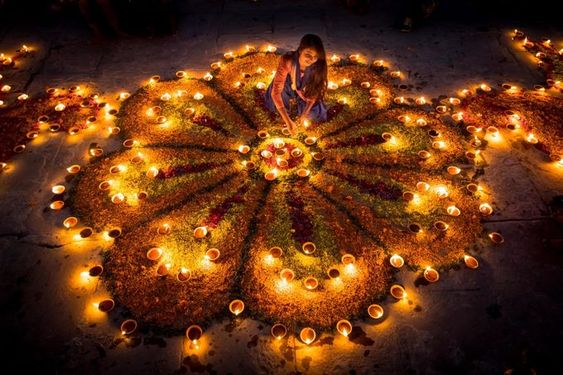Durga Puja: The Festival of the Goddess
Durga puja 2024 | 9 Oct, 2024 – 13 Oct
In India, the state of West Bengal and the global Bengali community celebrate Durga Puja with much pomp and ceremony. The primary events of this colourful and spectacular celebration take place during the course of the final four days of the festival, which continue for a total of ten. Goddess Durga, the celestial personification of feminine power and fortitude, is honoured during the festival of Durga Puja. The Hindu month of Ashwin is when the celebration is held, and it normally occurs in late September or early October. Durga Puja celebrates the goddess’s victory over the demon ruler Mahishasura, and its central theme is the triumph of good over evil.
Months before Durga Puja, communities, or “puja committees,” organise the construction of spectacular temporary structures called “pandals.” Idols of Durga and her children Ganesh, Lakshmi, Saraswati, and Kartik are kept in these elaborate pandals. During the occasion, people from all walks of life flock to the pandals to worship the goddess and seek her blessings. Around the pandals, people gather to watch and participate in cultural performances, traditional music, and dancing events. The immersion of the idols in rivers or other bodies of water during Durga Puja is an important ritual since it represents the goddess’s ascension back to heaven.
Spectacular processions, complete with music and dance, fill the streets, fostering a sense of grandeur and solidarity. Durga Puja is more than simply a religious celebration; it’s also a cultural spectacular where people get together to honour the goddess and revel in their shared heritage. It is a magnificent experience that captures the spirit of Bengali culture and stays with all who watch it.
Importance in Mythology of Durga Puja
Celebrating Durga’s triumph over Mahishasura, the demon ruler, is the purpose of Durga Puja. As depicted in Hindu mythology, Mahishasura was an unbeatable demon because of his shapeshifting abilities. Durga, the Hindu goddess of power and victory, was fashioned as a fierce warrior after gods besought her to do battle. After a gruelling nine days and nights of battle, she finally vanquished Mahishasura on the tenth day, which is celebrated as Vijayadashami.
- Time Period and Duration : Beginning on the sixth day (Shashti) and ending on the tenth day (Vijayadashami or Dashami), Durga Puja is celebrated for a total of ten days. The final four days, known as “Durgotsav,” are when the bulk of the festivities take place.
- A Classical Icon of Durga : An intricately sculpted clay figure of Durga is worshipped during the festival of Durga Puja. The deity is shown riding a lion and killing the demon Mahishasura on the idol. She has four offspring: the deities Saraswati (the goddess of knowledge), Lakshmi (the goddess of wealth), Ganesha (the remover of obstacles), and Kartikeya (the god of the bow).
- Puja and other Rites : There are several rites and ceremonies performed during Durga Puja. Mantra chanting, flower and incense offerings, and other rituals are central to the puja (worship) performed to the goddess. To gain the favour of the goddess, priests and worshippers perform aarti, a ceremony that involves the waving of lamps.
- Cultural Expression: The Dhunuchi Dance : The Dhunuchi dance is an integral part of the Durga Puja celebration. This dance is performed by devotees at the evening aarti while holding incense burners (dhunuchis). The dancers’ hypnotic movements and boundless energy to the traditional melody are mesmerising.
- Artistic Presentations : In addition to its religious significance, Durga Puja is also a cultural celebration. The idol is housed in a structure called a pandal, which is decorated elaborately for the occasion. These pandals are frequently creatively themed and created, showing a wide range of artistic and artisanal abilities. The pandals host cultural events such as musical and theatrical performances.
- Festivals and Gatherings : Communities as a whole celebrate Durga Puja with great enthusiasm. Everyone from every caste, creed, and background joins together at this time to celebrate the goddess’s triumph. During this time, it is normal practise for people to travel from one pandal to another in order to take in the varied displays of art and decoration.
- Khela Sindoor : Married women celebrate the final day of Durga Puja with a ritual known as Sindoor Khela. Vermilion (sindoor) is applied to the goddess’s idol and the couple themselves as a symbol of wedded love and a hope for a prosperous and long marriage.
Day 1: Shailaputri Puja
On the first day of Durga Puja, Goddess Shailaputri is revered as the festival’s patron deity. Having a divine provenance is reflected in her name, which means “daughter of the mountains” in the local language. Sati, Lord Shiva’s first wife, is said to have been reborn in her. Many people all around the country are looking forward to today. Shailaputri’s statue gets the royal treatment, with elaborate clothing and precious jewellery. Flowers are a sign of purity and devotion, thus it’s appropriate to give them as a gift.
Beyond the ceremonies, Shailaputri Puja holds immense significance. It heralds the beginning of the nine-day festival honouring the majesty of the feminine divine. On this day, devotees show their devotion and spiritual fortitude by refraining from food and water until the puja is over.
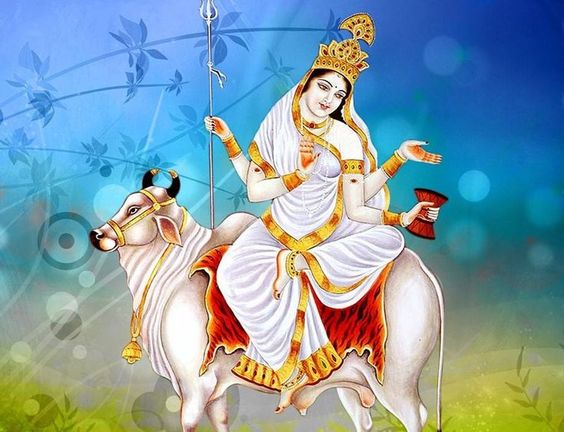
Many people believe that Shailaputri’s worship will improve their health, stamina, and fortune. Her heavenly grace is sought in order to triumph over difficulties, much like she did when she pushed over insurmountable mountains.Devotees pray to the goddess Shailaputri, singing hymns and reciting mantras as the priest performs the puja procedures.
It’s a time for families to pray together, which strengthens their links of love and dedication to one another and to God. The Shailaputri Puja on the first day of Durga Puja captures the spirit of the entire festival, which is a tribute to the heavenly mother’s unending might and beauty. It represents the first step on a path towards spiritual enlightenment, one that promises fulfilment and a deeper relationship with God.
Following the festival, worshippers continue to worship Goddess Durga in her many guises, each with its own set of rituals and traditions. Durga Puja is one of India’s most beloved celebrations because of its spiritual significance and spectacular splendour.
Day 2: Brahmacharini Puja
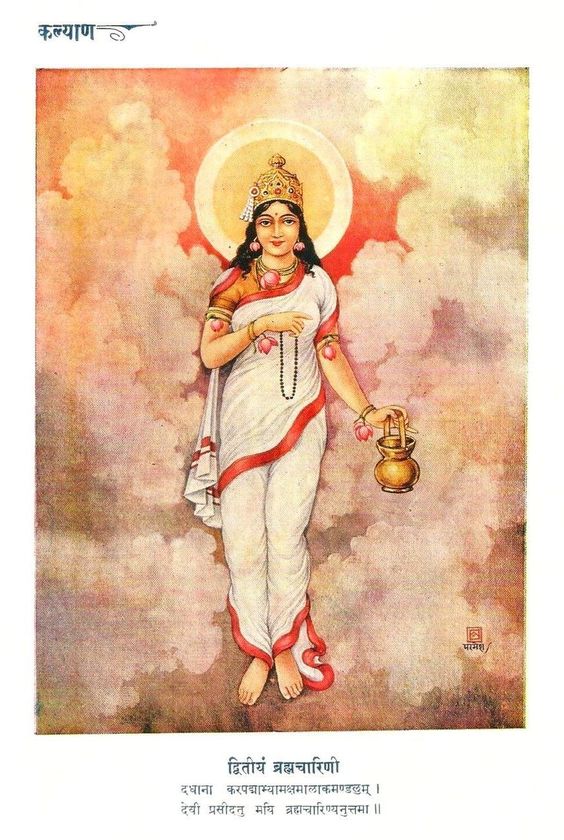
The ascetic guise of Durga, Goddess Brahmacharini, is honoured by worshippers on the second day of the festival. The devotion of this Goddess to enlightenment and asceticism has earned her veneration. With a name that can be translated to mean either “one who practises celibacy” or “one who pursues the sacred knowledge,” Brahmacharini is the personification of restraint, purity, and dedication.
She is shown with a kamandalu (a water jug) in one hand and a rudraksha mala (prayer beads) in the other. Her plain clothes are a symbol of her refusal to indulge in material things. On this day, devotees refrain from eating anything but fruits and milk. In emulation of Brahmacharini’s ascetic lifestyle, this symbolic fasting is intended to cleanse both body and soul. It is a time for reflection, contemplation, and the seeking of enlightenment.
The Brahmacharini Puja is a time for spiritual reflection and the pursuit of enlightenment. Invoking Goddess Brahmacharini is thought to help one rein in their passions and develop a sense of moral rectitude. For those who follow her, the Goddess in this guise illuminates the way to a life of virtue.The spiritual journey begun on the first day of Durga Puja with Shailaputri Puja is reinforced on the second day with Brahmacharini Puja.
Discipline, self-control, and personal development are emphasised. Many people look up to Goddess Brahmacharini and try to model their own lives after hers in order to better themselves spiritually and socially. Hymns and chants to Goddess Brahmacharini are chanted during the puja, setting the mood for quiet reflection. Flowers, incense, and other sacred offerings are commonly given by devotees at temples and pandals as a sign of their devotion.
Brahmacharini Puja, celebrated on the second day of Durga Puja, is a poignant reminder of the life-altering potential of faith and learning. It inspires people to take the first step on a journey of self-awareness and personal development that will bring them closer to a life of justice and serenity.
Day 3: Chandraghanta Puja

The third day of Durga Puja is dedicated to Chandraghanta, the third incarnation of the goddess. The meaning of her name, “one who has a moon-shaped bell,” is “one who is strong, courageous, and graceful.” She has been depicted with 10 arms, each one wielding a different weapon or sign of power, and a third eye on her forehead. Chandraghanta gets her moniker from the crescent moon symbol she wears on her forehead. Even in the midst of the fiercest wars, the moon is a sign of calm and peace. It represents the Goddess’s victory over evil and her bestowal of tranquilly upon her followers.
The followers of Chandraghanta believe she can ward off evil spirits and harmful energy. Fear strikes into the hearts of her enemies at the sight of her, making her an unstoppable force. Her followers look to her as a source of moral fortitude and the confidence to tackle adversity head-on. Chandraghanta Puja is a religious festival celebrated by devotees. On this day, people traditionally wear red to show their courage. Her favour is sought by reciting special mantras, songs, and prayers. Kheer (rice pudding) and other sweets are offered to the Goddess.
The Chandraghanta Puja celebrates the ferocious Goddess and her ability to vanquish evil and hardship with the power of fortitude and tenacity. Her followers pray for the strength to face and conquer both spiritual and material challenges. Chandraghanta is honoured on the third day of Durga Puja, heightening the religious intensity of the celebration. It bolsters the conviction that God’s grace may equip people with the fortitude to face adversity head-on and come out on top.
Day 4: Kushmanda Puja
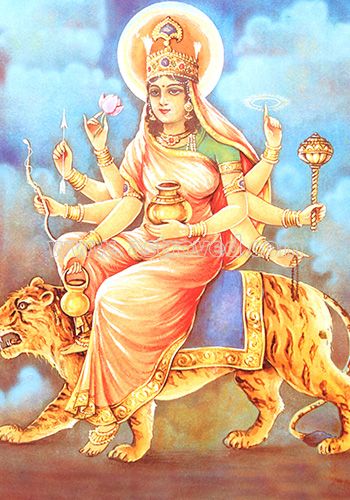
Devotees worship Goddess Kushmanda, the fourth incarnation of Durga, on the fourth day of the festival. Her name, Kushmanda, comes from three different Sanskrit words: (Ku), (Ushma), and (Anda), which together signify “cosmic egg.” Together, they represent her status as the universe’s maker.Each of Kushmanda’s eight arms is shown as wielding a different holy weapon or symbol. She is commonly depicted in artwork riding a lion, which is meant to represent her powerful and protective nature. Her beautiful grin is said to banish evil and bring joy to everyone who beholds it.
Kushmanda’s cosmic egg is one of his most iconic motifs. It symbolises the embryonic world and is thought to have been birthed by the Goddess’s divine force. It is said that the universe itself owes its existence to the air she breathed.
On Kushmanda Puja, believers pray for inspiration, vitality, and energy. It is thought that paying homage to her will provide you the energy you need to fight off spiritual and bodily exhaustion. The blessings of the goddess are sought so that one may live with renewed zeal and energy. Kushmanda Puja is a religious festival celebrated by devotees. Red, a colour signifying strength and vitality, is traditionally connected with this day. Spiritual resonance is created by the chanting of prayers and mantras to the Goddess.
Honey and other sweets are given as a way to appease her. Kushmanda Puja celebrates the heavenly mother in her role as source of inspiration and sustenance. It stresses the belief that Goddess Kushmanda’s energy permeates the entire cosmos, and that receiving her blessings can reawaken the dormant fires of our imagination and vitality. The spiritual significance of Durga Puja increases on the fourth day, Kushmanda’s day. Those who practise this faith regularly give thanks for the richness of life and the boundless opportunity for innovation in their environment.
Day 5: Skandamata Puja

Goddess Skandamata, mother of Lord Kartikeya (also known as Skanda or Murugan), is honoured on the fifth day of Durga Puja. The name “Skandamata” is a combination of the words “Skanda” (Lord Kartikeya) and “Mata” (mother), highlighting her maternal function.Skandamata, the goddess, is often shown with her infant son Kartikeya sitting on her lap. The calmness of her demeanour and the four arms she carries are symbols of the nurturing care of a mother. Her loyal mount, the lion, is close, representing her valour and bravery. During Skandamata Puja, worshippers pray to the holy mother for her protection and blessings on their children. Many people believe that the Goddess will protect and help them once they become parents.
Skandamata is more than just a mother figure; she symbolises the strength of mothers everywhere in their ability to care for and love their children no matter what. Her followers perceive her as a conduit to the divine, and as such, they pray to her for the blessings of enlightenment and fortitude.
The royal blue worn on Skandamata Puja represents the tranquilly and peace of a mother’s affection. Mantras, hymns, and special prayers are chanted to the Goddess. Bananas and other fruits are given as offerings to represent prosperity and sustenance.
Skandamata Puja celebrates the unwavering devotion and safeguarding care that mothers offer their offspring. It prompts worshippers to consider their own capacity for nurturing and to ask the Goddess for advice on how to best care for their children, both material and ethereal.The emotional and spiritual significance of Durga Puja grows on the festival’s fifth day, Skandamata’s day. Those who worship the divine mother give thanks for motherhood and her nurturing embrace.
Day 6: Katyayani Puja
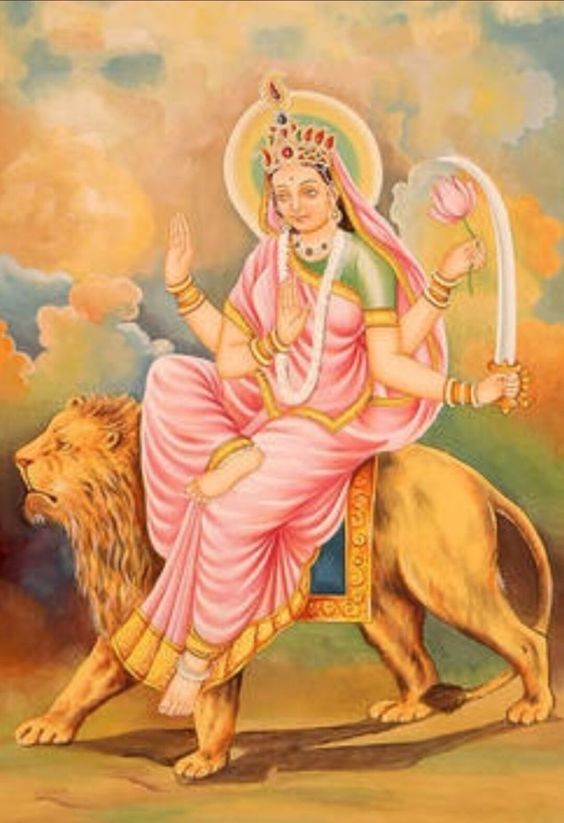
Devotees celebrate Goddess Katyayani, a strong and warrior-like aspect of Durga, on the sixth day of Durga Puja. The sage Katya, who was instrumental in her heavenly incarnation, is honoured by the epithet “Katyayana,” from which “Katyayani” is derived. The four-armed goddess Katyayani is often shown with a sword and a lotus in two of her hands, while the other two are in mudras representing courage and blessings. She exudes an air of strength that speaks of bravery and determination. Her ferocious appearance is meant to instill courage and fortitude in her followers.
The Hindu goddess Katyayani is said to have appeared in response to Sage Katyayana’s earnest requests. He hoped that God will take human form in order to vanquish the terrifying demon Mahishasura. The victory of good over evil was secured by Katyayani’s heavenly force and fierce determination.
During Katyayani Puja, worshippers ask for the Goddess’ help in shattering their fears and achieving their goals. Her ferocious appearance symbolises the vanquishing of one’s own personal demons in order to face external challenges head-on.Katyayani Puja’s signature hue is yellow, which stands for positivity and bravery. In homage to the Goddess, worshippers say mantras, light candles, and chant prayers during aarti rites. Honey and other sweets are given to her as a way to ask for her favour.
Katyayani Puja is a celebration of the power of the individual to overcome adversity and embrace the unknown. In order to face the challenges of life head-on, devotees pray to the Goddess for strength.
Today, the sixth day of Durga Puja, is dedicated to Katyayani, and the festival’s focus on the power of the individual to overcome adversity grows more profound. Those who worship the divine mother often focus on her fiery and protective side.
Day 7: Kalaratri Puja
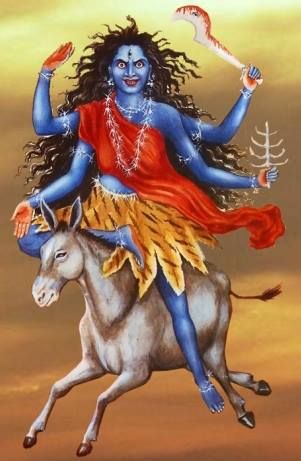
Devotees honour Goddess Kalaratri, a violent and dark incarnation of Durga, on the seventh day of Durga Puja. Her name, Kalaratri, means “the one who is as black as the night,” which is meant to convey the might and invulnerability she exudes.Wild, dishevelled hair, a large tongue, and a ferocious expression are all characteristics of the Kalaratri goddess. She’s armed to the teeth with a cleaver and a flaming torch, ready to drive out the night and crush the forces of evil. Her donkey of a mount stands for intransigence and refusing to give in to adversity.
The Kalaratri Puja is revered because its followers believe it will shield them from evil and destructive influences. The Goddess’s fearsome form is a potent weapon against evil, striking terror into the hearts of her enemies. Her followers pray for protection from the shadows, both figuratively and practically.
It’s interesting to note that Kalaratri’s fierce appearance also represents innocence. Like fire cleaning gold of its impurities, so Kalaratri’s ferocious nature cleanses the devotee’s soul of all negativity.
In the Hindu festival of Kalaratri Puja, the colour white is worn to represent chastity and tranquillity. In order to gain the favour of the Goddess, devotees pray, chant mantras, and engage in rituals. Jaggery and other sweets are given as offerings to win her favour. Kalaratri Puja is a celebration of the triumph of good over evil, and a reminder that hope may be found even in the midst of tragedy. Followers pray to the Goddess for the strength to face adversity and triumph anyway.
Today, the seventh day of Durga Puja, is Kalaratri, and the festival’s focus on the triumph of light over darkness grows even stronger. Those who worship the divine mother often focus on her fiery and protective side.
Day 8: Mahagauri Puja
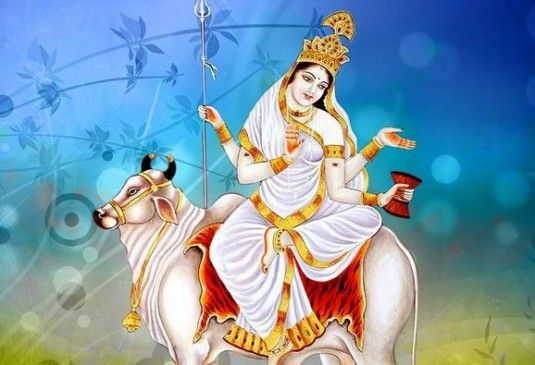
Devotees honour Goddess Mahagauri, who is known for her chaste and calm demeanour, on the eighth day of Durga Puja. “Mahagauri” means “the one who is extremely fair,” a fitting moniker for her flawless and luminous complexion.
Usually represented with four limbs and a white robe, Goddess Mahagauri stands for piety, harmony, and peace. Her peaceful appearance exudes an air of contentment and peace. She’s holding a trident in one hand and a blessing in the other. The bull is her steed because it is a symbol of Dharma (goodness).
During Mahagauri Puja, believers petition the Goddess for the serenity and contentment they want. Her gentle and peaceful appearance is thought to cleanse her followers’ souls and lead them to a more peaceful existence. The Mahagauri cult celebrates the transformational potential of moral rectitude and purity. Followers are encouraged to improve themselves by embracing positive traits, rejecting destructive ones, and living a life of charity and compassion. Pink is the traditional colour used on Mahagauri Puja because it represents love, innocence, and devotion. Worshippers honour the Goddess with supplications, mantra chanting, and other acts of devotion. Milk and sweets are given as a sacrifice to appease her.
Purity of mind and soul is a potent force that can bring one happiness and spiritual development, and Mahagauri Puja serves as a reminder of this. Followers of the Goddess pray for her favour in order to rectify their ways of thinking and behaving so that they may enjoy a peaceful and righteous existence.
On this, the eighth day of Durga Puja, Mahagauri is honoured, and the festival’s focus shifts even more inward towards personal renewal and the search for peace. Those who worship the Goddess do so in recognition of her pristine and tranquil nature.
Day 9: Siddhidatri Puja
The ninth and last day of Durga Puja is dedicated to Goddess Siddhidatri, who is honoured for bestowing magical abilities and favours upon her worshippers. Her name, Siddhidatri, means “the giver of Siddhis,” or mystical abilities. The celestial goddess Siddhidatri is often represented with four arms. She has the power over all of creation, as represented by the four symbols she holds in her hands: a mace, a lotus, a discus, and a conch shell. The lion, a symbol of power and bravery, serves as her mount.

During Siddhidatri Puja, worshippers ask for the Goddess’s help in achieving ethereal and mystical goals. It is claimed that her supernatural grace can help believers overcome earthly confines and difficulties. The attainment of a siddhi is commonly viewed as a step towards enlightenment. Clairvoyance, healing, telepathy, and even levitation are all examples of such powers. The spiritual growth of her devotees depends on their ability to control these forces, thus they pray to Siddhidatri for her grace.
The colour purple, representing mystical spirituality, is traditionally worn for Siddhidatri Puja. Worshippers honour the Goddess with supplications, mantra chanting, and other acts of devotion. To win her approval, people bring her gifts of fruit and sweets.
A celebration of the boundless potential of the human spirit, Siddhidatri Puja is held annually. Followers of the Goddess pray to her not just for the gifts of the supernatural but also for the insight to put those gifts to good use. During Durga Puja, it represents the pinnacle of a person’s spiritual quest. In honour of Siddhidatri, the ninth and last day of Durga Puja is the festival’s pinnacle. Believers give thanks to the holy mother for helping them develop their spirituality.
Day 10 : Vijayadashami
On the final day of the event, known as Vijayadashami, worshippers say their final goodbyes to Goddess Durga. The day is bittersweet because believers anticipate saying goodbye to the goddess as she returns to her heavenly home from her time spent among humans. The immersion of the Durga image into a river, lake, or pond is the most important rite of Vijayadashami. The goddess’s departure is represented by this ritual. The journey of the idol to the place of immersion is marked by elaborate processions. Music, dance, and the recitation of hymns and mantras are common components of these processions. Worshippers accompany the idol in a parade while singing and dancing in their finest apparel.
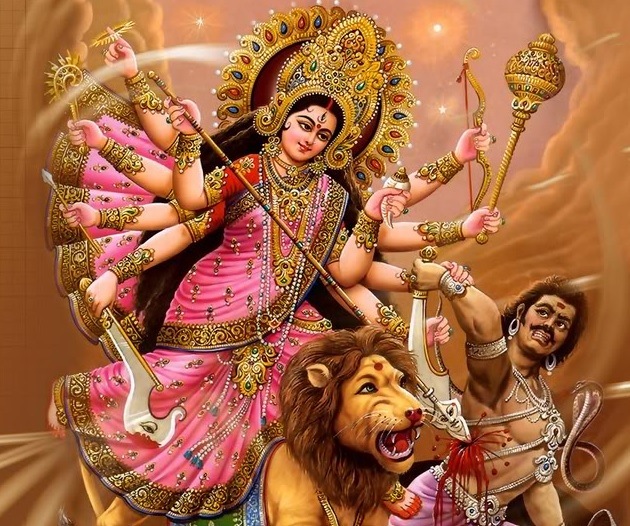
To see how people celebrate Durga Puja Click on this link -> https://youtu.be/N8eNTFEPFsM?si=I6UI6hI2B6WsXfel
Some Famous Quotes on Durga Puja
“दुर्गा पूजा सिर्फ एक त्योहार नहीं है; यह एक भगवानीता, एकता, और अच्छाई की विजय की भावना है।”
“मां दुर्गा की आशीर्वाद आपके जीवन को खुशी, समृद्धि, और अनंत खुशियों से भर दे इस पूजा के दौरान।”
“दुर्गा पूजा मां दुर्गा से शक्ति प्राप्त करने और परिवार और दोस्तों के साथ एकता की आत्मा का जश्न मनाने का समय है।”
“जब ढक (ढोलक) की ध्वनि आसमान में गूंथती है, तो यह आपके दिल की धड़कन के साथ बढ़े, भक्ति और मां दुर्गा के प्रति प्यार से भरी हो।”
“दुर्गा पूजा के रंग, बत्तियों और खुशी से हमारे संस्कृति की धरोहर की विविधता को सामने लाते हैं।”
“दुर्गा पूजा के दौरान हम केवल देवी की पूजा नहीं करते; हम एक महिला की अड़चन का जश्न मनाते हैं।”
“धूप की महक, दियों की चमक, और दुर्गा पूजा की दिव्य आकृति आपके जीवन को शांति और आध्यात्मिकता से भर दें।”
“दुर्गा पूजा हमारी आंतरिक शक्ति पर विचार करने का समय है, बिल्कुल उसी तरह जैसे देवी जो वीरता और गरिमा के साथ दुर्गम युद्ध किया।”
“यह दुर्गा पूजा हमें याद दिलाने का समय हो, कि चुनौतियों कितनी ही बड़ी हो, हम उन्हें दृढ़ता और विश्वास के साथ पार कर सकते हैं।”
“दुर्गा पूजा संस्कृति और उत्सव का मेल है, जहाँ आस्था जीवन के उल्लास से मिलती है, और हम देवी की आशीर्वादों में आनंदित होते हैं।”

